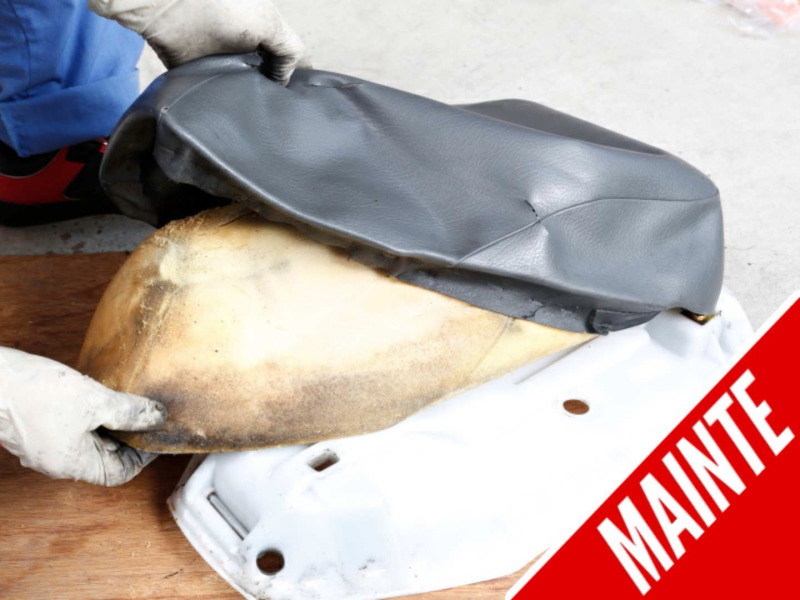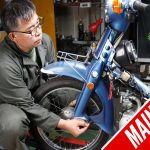When the seat surface gets perforated due to age or mischief, rainwater that has entered through the perforation will seep out forever. Even if you use gummed tape to temporarily fix the problem, it will soon reappear, and the sticky tape is also unpleasant. In such a case, the best solution is to replace the seat, and if the model is sold with a three-dimensional cut surface, you can expect a very high-quality finish.
You're lucky if your model has a special surface for your motorcycle model.
 A scooter seat that has a small tear on the front of the seat and the front part of the seat has peeled off due to age and deterioration. But once the sponge absorbs moisture, it's hard to dry, and every time you sit on it, it seeps out from the inside, often making you feel uncomfortable.
A scooter seat that has a small tear on the front of the seat and the front part of the seat has peeled off due to age and deterioration. But once the sponge absorbs moisture, it's hard to dry, and every time you sit on it, it seeps out from the inside, often making you feel uncomfortable.
 When you remove the surface skin by pulling out the needle of the tacker with a tool with a sharp edge such as nippers, the surface of the sponge under the area where the surface skin was avoided is scraped and scraped. The longer the treatment is delayed, the more the damage to the sponge progresses, and even if the surface skin is replaced, the dent may still be noticeable. If the sponge itself is damp, do not reupholster it immediately, but dry it in the shade in a well-ventilated place even for a few days to dry it. When you pull out the needle of the tacker, if it remains broken on the bottom of the seat, do not leave it as it is, but pull it out.
When you remove the surface skin by pulling out the needle of the tacker with a tool with a sharp edge such as nippers, the surface of the sponge under the area where the surface skin was avoided is scraped and scraped. The longer the treatment is delayed, the more the damage to the sponge progresses, and even if the surface skin is replaced, the dent may still be noticeable. If the sponge itself is damp, do not reupholster it immediately, but dry it in the shade in a well-ventilated place even for a few days to dry it. When you pull out the needle of the tacker, if it remains broken on the bottom of the seat, do not leave it as it is, but pull it out.
The seat is an important part that supports the rider throughout the ride. Unlike the fuel tank, cowl and other exterior parts, which can be polished with wax or coating, the seat can be given a quick wash with car shampoo and that's it.
The only time such a seat attracts attention is when the skin of the seat becomes frayed, cut, or otherwise defective. There are a variety of causes, including age-related deterioration and annoying mischief, but if the seat skin is cut or punctured, water will seep through, making it uncomfortable for the rider. Some owners of scooters and small-displacement vehicles cover the entire seat with a plastic bag or wildly apply duct tape, but it doesn't look good, the plastic bag sheet is slippery, and the duct tape is a hassle to clean up when the glue gets on your clothes.
If the motorcycle is newer in age, there may be a seat assembly available as a genuine part, so replacing it with that is quick and easy. However, seats as parts are more expensive than you might think. So the next best thing is to ask a seat shop to reupholster it. It would be a good idea to have the seat reupholstered in a pure orthodox style using a general-purpose seat fabric, or you can use this opportunity to customize the seat.
Another option is to reupholster the seat yourself, as the DIY trend has led to videos on the internet showing techniques for reupholstering living room chairs and even sofas. Motorcycle seats are more undulating than dining chairs and sofas, so it's not easy to cleanly reupholster a single piece of seat skin. However, if you search video sites, you will find that some people are able to recreate a 3D effect by cutting and sewing parts of the seat together.
If you want a more convenient finish, look for reupholstery upholstery that is made to fit the shape of the seat in your model of motorcycle. For moped scooters and business motorcycles, you can find relatively inexpensive upholstery that is made to look like the original. There are also models with flashy colored upholstery that can be used for customization as well as repair.
- Point 1・When the seat surface skin is worn or cut, the sponge is easily damaged by rainwater, so repair it as soon as possible.
- Point 2・High quality reupholstery is possible by utilizing sewn surface skins that are exclusive to the model.
If you want a clean stakeout, you need a tucker.
 If you use an air tacker, which fires a needle vigorously with air from a compressor, you can hit the seat base even if the resin is hard. The manual tacker is attractive because of its low price, but the momentum of the needle is weaker than that of the air or electric tacker, so it often bends without breaking through the surface of the seat base.
If you use an air tacker, which fires a needle vigorously with air from a compressor, you can hit the seat base even if the resin is hard. The manual tacker is attractive because of its low price, but the momentum of the needle is weaker than that of the air or electric tacker, so it often bends without breaking through the surface of the seat base.
There are various kinds of seat covers from sewn by machine to high frequency welded like genuine. Even if the size is the same as genuine, you may need some tips when sticking it. Tackers are required for upholstering the seat upholstery.
A tacker is a fixture like the thumb of a stapler, and it fixes the surface skin to the seat base with a U-shaped needle-like metal fitting. A stationery stapler has a mating part that catches the needle that pops out, but when you fix the seat skin, you just stick the needle into the seat base. Therefore, it is necessary to fire the needle vigorously.
There are three types of tuckers: manual, electric, and pneumatic.In terms of cost, the manual type has the advantage. The price of the electric or pneumatic type of equipment is moderately expensive, but the power to launch the needle makes the hardness of the sheet baseless of a concern. If you've decided to apply only one sheet in front of you, it may seem like a waste to buy an electric or pneumatic tacker, but it may be a good investment in terms of the possibility of doing many things in the future.
If you are looking for the best finish when upholstering the seat upholstery, the key is to always apply tension to the upholstery while working to prevent wrinkles. After aligning the center line of the seat with the center of the upholstery, apply the first tacker to either the front or the back. If you have decided on the front side first, then drive the needle into the centre of the back side, pulling the outer skin tightly.
At this time, if you use a manual tacker, you need a lot of force to hit the needle while pulling the epidermis. If you are not careful, the surface skin tends to loosen or the tacker tends to hit the needle too hard. On the other hand, with an electric or pneumatic tacker, all you have to do is hold the trigger and the needle flies out vigorously, so you can concentrate only on pulling the surface skin. As a result, you will definitely get a better finish. Even if you need to reupholster a part of the seat because of wrinkles, you only need to hold the trigger to reupholster it again and again, so you can do it without compromise. The electric or pneumatic tacker is a tool that is only used for seat re-upholstery in motorcycle maintenance, but in return, the electric or pneumatic tacker shows overwhelming performance in seat re-upholstery.
- Point 1・To fix the seat upholstery to the seat bottom, it is convenient to have a tacker to hit the fixing metal.
- Point2・The power type such as air type or electric type fires the needle more vigorously than the manual type tacker, so you can concentrate on the stakeout.
Whether or not to put a tarpaulin between the skin and the sponge depends on the situation.
 Since the surface skin used is sewn and the front edge of the sponge is crumbling, a tarpaulin is used together. If the tarpaulin is too thick, the wrinkles of the tarpaulin may be seen under the stretched skin, and if the tarpaulin is too thin, the tarpaulin may rub between the skin and the sponge. Because it is for business scooters that do not move their weight on the seat as much as sports motorcycles, use a thicker vinyl to emphasize waterproofness.
Since the surface skin used is sewn and the front edge of the sponge is crumbling, a tarpaulin is used together. If the tarpaulin is too thick, the wrinkles of the tarpaulin may be seen under the stretched skin, and if the tarpaulin is too thin, the tarpaulin may rub between the skin and the sponge. Because it is for business scooters that do not move their weight on the seat as much as sports motorcycles, use a thicker vinyl to emphasize waterproofness.
 The seat cover we used is made by NTB, and they have numerous model specific covers for everything from scooters to sport motorcycles. The price at Webic for the UA03J we worked on was 2797 yen including tax. At this price, it's probably a good idea to reupholster rather than use gummed tape. The only hurdle is the tacker you need.
The seat cover we used is made by NTB, and they have numerous model specific covers for everything from scooters to sport motorcycles. The price at Webic for the UA03J we worked on was 2797 yen including tax. At this price, it's probably a good idea to reupholster rather than use gummed tape. The only hurdle is the tacker you need.
 Even for moped scooters, the price of a seat as a component is close to 19,000 yen (in the case of Yamaha News Gear), so it is not inexpensive. If the seat base and sponge can be reused, it is reasonable to choose an external manufacturer's seat upholstery. Considering the price of a new stock seat, the choice of upholstery and tacker is not a bad one.
Even for moped scooters, the price of a seat as a component is close to 19,000 yen (in the case of Yamaha News Gear), so it is not inexpensive. If the seat base and sponge can be reused, it is reasonable to choose an external manufacturer's seat upholstery. Considering the price of a new stock seat, the choice of upholstery and tacker is not a bad one.
Whether or not to put a tarpaulin between the skin and the seat sponge needs to be considered based on the condition of the sponge and the structure of the skin to be stretched. In 1960's motorcycles where the seat base was steel plate and coarse sponge was used, there were some models with vinyl sandwiched between the outer skin and sponge. The purpose of this was to prevent water from seeping into the sponge through the seams. On the other hand, most of today's genuine seat covers are welded without seams, and even if sewing machines are used for decoration, the backside is sealed, so the sponge does not absorb rainwater.
However, if you are reupholstering for repair purposes, the situation is different. If the seat upholstery has been cut by a malicious prankster, the sponge may also have a blade in it. In this case, a rubber adhesive is applied to the cut surface to prevent it from shifting before reupholstering, but the adhesive part will inevitably move compared to the other parts. However, the adhesive part will move more than the other parts. In such a case, adding a layer of adhesive between the seat upholstery and the sponge has an advantage to reduce the friction between the sponge and the seat upholstery. However, since the surface skin moves more easily, the seat may feel less comfortable to hold.
If the surface to be replaced has a sewn finish, rainwater may enter through the seams, so the sheet may be inserted to keep the sponge dry. Even with a sewn finish custom upholstery, a sponge protection sheet may be used. You may choose not to use a tarp after doing so, as you can rub caulk into the seams from the backside before putting on the skin to help seal the seams.
Because the seat is the part that the rider always touches, it is important to keep it in good condition. Of course, it is a matter of appearance, but it is also advisable to replace damaged upholstery as soon as possible so as not to impair the original function of the seat.
- Point 1・Whether to use a tarpaulin or not depends on the waterproofness of the seat surface skin itself and the condition of the sponge.
- Point 2・In the case of sewn seat covers, it may be possible to prevent rainwater from entering by applying caulking agent from the back side.



